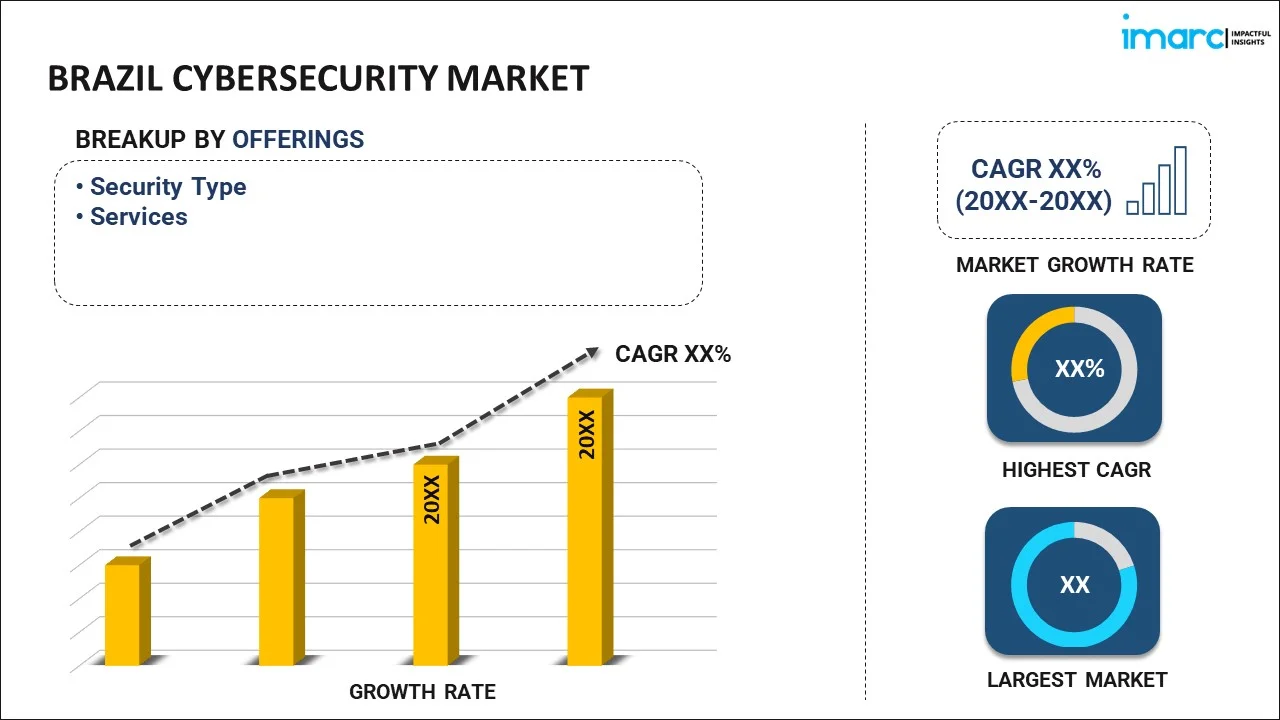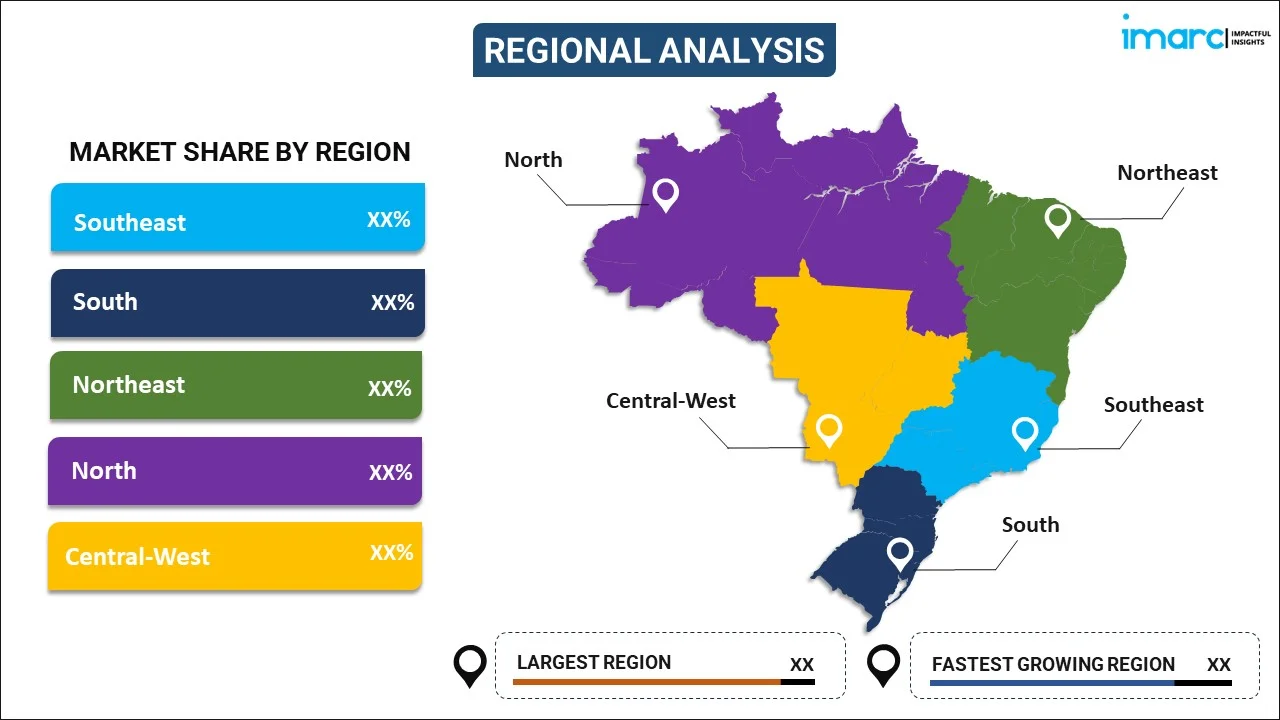
Brazil Cybersecurity Market Report by Offering (Security Type, Services), Deployment (Cloud, On-premise), End User (BFSI, Healthcare, Manufacturing, Government and Defense, IT and Telecommunication, and Others), and Region 2024-2032
Market Overview:
Brazil cybersecurity market size is projected to exhibit a growth rate (CAGR) of 9.36% during 2024-2032. The significant expansion in the healthcare sector, widespread adoption of digital transformation initiatives, emerging technological advancements, and growing cyber threats and attacks targeting businesses, government institutions, and individuals represent some of the key factors driving the market.
|
Report Attribute
|
Key Statistics
|
|---|---|
|
Base Year
|
2023 |
|
Forecast Years
|
2024-2032
|
|
Historical Years
|
2018-2023
|
| Market Growth Rate (2024-2032) | 9.36% |
Cybersecurity is an essential facet of modern information technology that focuses on safeguarding networks, digital systems, and data from unauthorized entree, damage, or theft. It is an essential and indispensable role in protecting individuals, organizations, and governments from numerous cyber threats. Nowadays, data is the lifeblood of businesses and individuals, resulting in the adoption of cybersecurity measures to maintain trust and privacy. These measures include various strategies, technologies, and practices, including firewalls, encryption, intrusion detection systems, and user authentication protocols. Additionally, there is a growing need for improved cybersecurity and the proliferation of connected devices and the internet. Also, organizations and individuals are updating their cybersecurity strategies. Regular training and awareness programs are essential to ensure that users understand and follow best practices. Nowadays, cybersecurity is an ever-evolving field essential to safeguarding against digital assets and maintaining the integrity of our interconnected world.
Brazil Cybersecurity Market Trends:
The market is primarily driven by the growing cyber threats and attacks targeting businesses, government institutions, and individuals. As technology advances, cybercriminals have become more sophisticated, making it imperative for organizations to invest in cybersecurity solutions. These threats range from data breaches and ransomware attacks to phishing scams, which can have severe financial and reputational consequences. Moreover, the widespread adoption of digital transformation initiatives across various technologies, such as cloud computing, the Internet of Things (IoT), and big data analytics, represents another major growth-inducing factor. Besides this, the increasing demand for cybersecurity services utilized across several industries in Brazil due to the increasing digitization of business processes is accelerating the market growth. Along with this, the growing financial sector, including banks, insurance companies, and fintech firms, relies heavily on cybersecurity due to the rising online banking and digital financial transactions, protecting customer data, financial assets, and the integrity of financial systems, is also propelling the market growth. Apart from this, the growing healthcare sector deals with large amounts of sensitive patient data, making it a prime target for cyberattacks, resulting in cybersecurity investments to safeguard patient confidentiality and protect electronic health records (EHRs). Also, several government institutions hold a wealth of sensitive data, ranging from citizen information to national security data; ensuring the security of government systems and protecting against cyber threats is essential for national security and public trust, thus augmenting market growth. Furthermore, the rising demand for cybersecurity in the manufacturing industry 4.0, which involves the integration of IoT devices and automation, makes manufacturing systems more interconnected and vulnerable to cyberattacks, which is creating a positive market outlook. Manufacturers are investing in cybersecurity to protect their industrial processes and intellectual property.
Brazil Cybersecurity Market Segmentation:
IMARC Group provides an analysis of the key trends in each segment of the market, along with forecasts at the country level for 2024-2032. Our report has categorized the market based on offering, deployment, and end user.
Offering Insights:

- Security Type
- Cloud Security
- Data Security
- Identity Access Management
- Network Security
- Consumer Security
- Infrastructure Protection
- Others
- Services
The report has provided a detailed breakup and analysis of the market based on the offering. This includes security type (cloud security, data security, identity access management, network security, consumer security, infrastructure protection, and others) and services.
Deployment Insights:
- Cloud
- On-premise
A detailed breakup and analysis of the market based on the deployment have also been provided in the report. This includes cloud and on-premise.
End User Insights:
- BFSI
- Healthcare
- Manufacturing
- Government and Defense
- IT and Telecommunication
- Others
The report has provided a detailed breakup and analysis of the market based on the end user. This includes BFSI, healthcare, manufacturing, government and defense, IT and telecommunication, and others.
Regional Insights:

- Southeast
- South
- Northeast
- North
- Central-West
The report has also provided a comprehensive analysis of all the major regional markets, which include Southeast, South, Northeast, North, and Central-West.
Competitive Landscape:
The market research report has also provided a comprehensive analysis of the competitive landscape in the market. Competitive analysis such as market structure, key player positioning, top winning strategies, competitive dashboard, and company evaluation quadrant has been covered in the report. Also, detailed profiles of all major companies have been provided.
Brazil Cybersecurity Market Report Coverage:
| Report Features | Details |
|---|---|
| Base Year of the Analysis | 2023 |
| Historical Period | 2018-2023 |
| Forecast Period | 2024-2032 |
| Units | US$ Million |
| Scope of the Report | Exploration of Historical Trends and Market Outlook, Industry Catalysts and Challenges, Segment-Wise Historical and Future Market Assessment:
|
| Offerings Covered |
|
| Deployments Covered | Cloud, On-premise |
| End Users Covered | BFSI, Healthcare, Manufacturing, Government and Defense, IT and Telecommunication, Others |
| Regions Covered | Southeast, South, Northeast, North, Central-West |
| Customization Scope | 10% Free Customization |
| Report Price and Purchase Option | Single User License: US$ 3699 Five User License: US$ 4699 Corporate License: US$ 5699 |
| Post-Sale Analyst Support | 10-12 Weeks |
| Delivery Format | PDF and Excel through Email (We can also provide the editable version of the report in PPT/Word format on special request) |
Key Questions Answered in This Report:
- How has the Brazil cybersecurity market performed so far and how will it perform in the coming years?
- What has been the impact of COVID-19 on the Brazil cybersecurity market?
- What is the breakup of the Brazil cybersecurity market on the basis of offering?
- What is the breakup of the Brazil cybersecurity market on the basis of deployment?
- What is the breakup of the Brazil cybersecurity market on the basis of end user?
- What are the various stages in the value chain of the Brazil cybersecurity market?
- What are the key driving factors and challenges in the Brazil cybersecurity?
- What is the structure of the Brazil cybersecurity market and who are the key players?
- What is the degree of competition in the Brazil cybersecurity market?
Key Benefits for Stakeholders:
- IMARC’s industry report offers a comprehensive quantitative analysis of various market segments, historical and current market trends, market forecasts, and dynamics of the Brazil cybersecurity market from 2018-2032.
- The research report provides the latest information on the market drivers, challenges, and opportunities in the Brazil cybersecurity market.
- Porter's five forces analysis assist stakeholders in assessing the impact of new entrants, competitive rivalry, supplier power, buyer power, and the threat of substitution. It helps stakeholders to analyze the level of competition within the Brazil cybersecurity industry and its attractiveness.
- Competitive landscape allows stakeholders to understand their competitive environment and provides an insight into the current positions of key players in the market.
Need more help?
- Speak to our experienced analysts for insights on the current market scenarios.
- Include additional segments and countries to customize the report as per your requirement.
- Gain an unparalleled competitive advantage in your domain by understanding how to utilize the report and positively impacting your operations and revenue.
- For further assistance, please connect with our analysts.
 Inquire Before Buying
Inquire Before Buying
 Speak to an Analyst
Speak to an Analyst
 Request Brochure
Request Brochure
 Request Customization
Request Customization




.webp)




.webp)












